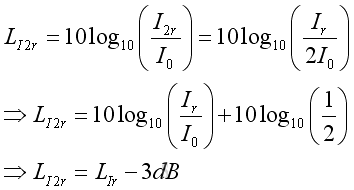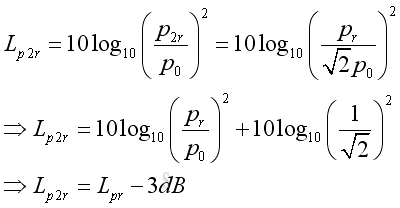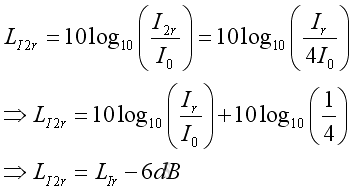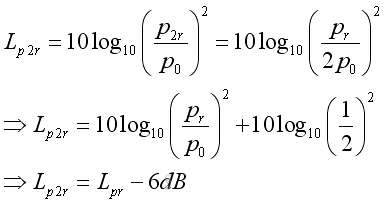Content
Sound Wavefronts
Plane waves
Cylindrical Waves
Spherical Waves
Sound Wavefronts
Plane waves
Plane waves are the form of wave propagation in one dimension. The wavefronts of plane waves are planes perpendicular to the propagation direction.
Plane waves are generated by a plane source. The surface area of wavefront does not vary with the distance away from the sound source. Since there is no geometrical divergence along the propagation path, both the sound intensity and sound pressure remain unchanged.
 and
and

where
Ax is the surface area at distance x and is a constant
Ix is the sound intensity at distance x
px is the sound pressure at distance x
Therefore, both the sound intensity level and the sound pressure level remains constant with distance away from the source.
Plane waves propagation can be found in musical pipe instrument, e.g. flutes, clarinets, or noise in ducts.
Cylindrical Waves
Cylindrical waves are the form of wave propagation in two dimension. The wavefronts of cylindrical waves are coaxial cylinders with axis of symmetry normal to the propagation direction.
Cylindrical waves are generated by a line source. The surface area of wavefront increases with the distance away from the sound source. Since there is geometrical divergence along the propagaton path, both the sound intensity and sound pressure decreases with distance away from the source.
 and
and

where
2πrh is the surface area at distance r
Ir is the sound intensity at distance r
pr is the sound intensity at distance r
2π(2r)h is the surface area at distance 2r
I2r is the sound intensity at distance 2r
p2r is the sound intensity at distance 2r
Therefore, both the sound intensity level in term of I and sound pressure level in term of p2 decrease by 3dB as the distance of receiver away from the source is increased by double.
 and
and

 and
and

where
LIr is the sound intensity level at distance r
Lp2r is the sound pressure level at distance r
Ir is the sound intensity at distance r
Io is the sound intensity reference
pr is the sound intensity at distance r
po is the sound pressure reference
LI2r is the sound intensity level at distance 2r
Lp2r is the sound pressure level at distance 2r
I2r is the sound intensity at distance 2r
p2r is the sound intensity at distance 2r
Cylindrical waves propagation can be found in sound radiation from a circular pipes or duct, or noise field in an open space radiated by a lane of closely spaced vehicles.
Spherical Waves
Spherical waves are the form of wave propagation in three dimension. The wavefronts of spherical waves are concentric spheres with center at the center of propagation in all directions.
Spherical waves are generated by a point source. The surface area of wavefront increases with the distance away from the sound source. Since there is geometrical divergence along the propagation path, both the sound intensity and sound pressure level decreases with distance away from the source.
 and
and

where
4πr2 is the surface area at distance r
Ir is the sound intensity at distance r
pr is the sound intensity at distance r
4π(2r)2 is the surface area at distance 2r
I2r is the sound intensity at distance 2r
p2r is the sound intensity at distance 2r
Therefore, both the sound intensity level in term of I and sound pressure level in term of p2 decrease by 6dB as the distance of receiver away from the source is increased by double.
 and
and

 and
and

where
LIr is the sound intensity level at distance r
Lp2r is the sound pressure level at distance r
Ir is the sound intensity at distance r
Io is the sound intensity reference
pr is the sound intensity at distance r
po is the sound pressure reference
LI2r is the sound intensity level at distance 2r
Lp2r is the sound pressure level at distance 2r
I2r is the sound intensity at distance 2r
p2r is the sound intensity at distance 2r
Spherical waves propagation in practical can be found by approximating a sound source with source dimension and radiated wavelength much smaller than the distance away from the receiver.
©sideway
ID: 100900010 Last Updated: 9/8/2010 Revision: 0 Ref:
References
- Michael P. Norton; Denis G. Karczub,, 2003, Fundamentals of Noise and Vibration Analysis for Engieer
- G. Porges, 1977, Applied Acoustics
- Conrad J. Hemond, 1983, Engineering Acoustics & Noise Control
- F. Fahy, 2001, Foundations of Engineering Acoustics
Latest Updated Links
- Travel Singapore Sight Mandai(last updated On 12/8/2025)
- Travel Singapore Sight Bird Paradise(last updated On 12/7/2025)
- Travel Singapore Sight(last updated On 12/6/2025)
- Travel Singapore Rail Network(last updated On 12/5/2025)
- Travel Singapore Things to Know(last updated On 12/4/2025)
- Travel Singapore(last updated On 12/3/2025)
- Legrand Galion(last updated On 12/2/2025)
- Schneider Electric AvatarOn(last updated On 12/1/2025)
- Alfalux(last updated On 11/30/2025)
- Novabell(last updated On 11/29/2025)
- TownGas NJW12RM1(last updated On 11/28/2025)

 Nu Html Checker
Nu Html Checker  53
53  na
na  na
na
Home 5
Business
Management
HBR 3
Information
Recreation
Hobbies 9
Culture
Chinese 1097
English 339
Travel 24
Reference 79
Hardware 54
Computer
Hardware 259
Software
Application 213
Digitization 37
Latex 52
Manim 205
KB 1
Numeric 19
Programming
Web 289
Unicode 504
HTML 66
CSS 65
SVG 46
ASP.NET 270
OS 431
DeskTop 7
Python 72
Knowledge
Mathematics
Formulas 8
Set 1
Logic 1
Algebra 84
Number Theory 206
Trigonometry 31
Geometry 34
Calculus 67
Engineering
Tables 8
Mechanical
Rigid Bodies
Statics 92
Dynamics 37
Fluid 5
Control
Acoustics 19
Natural Sciences
Matter 1
Electric 27
Biology 1
